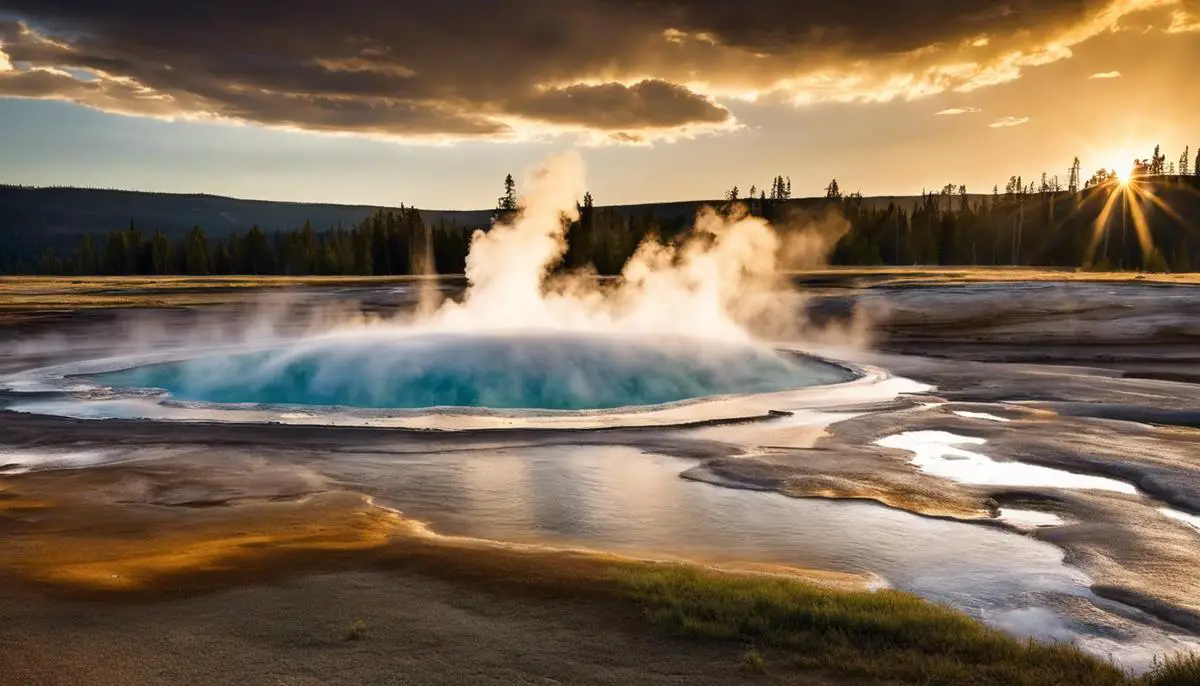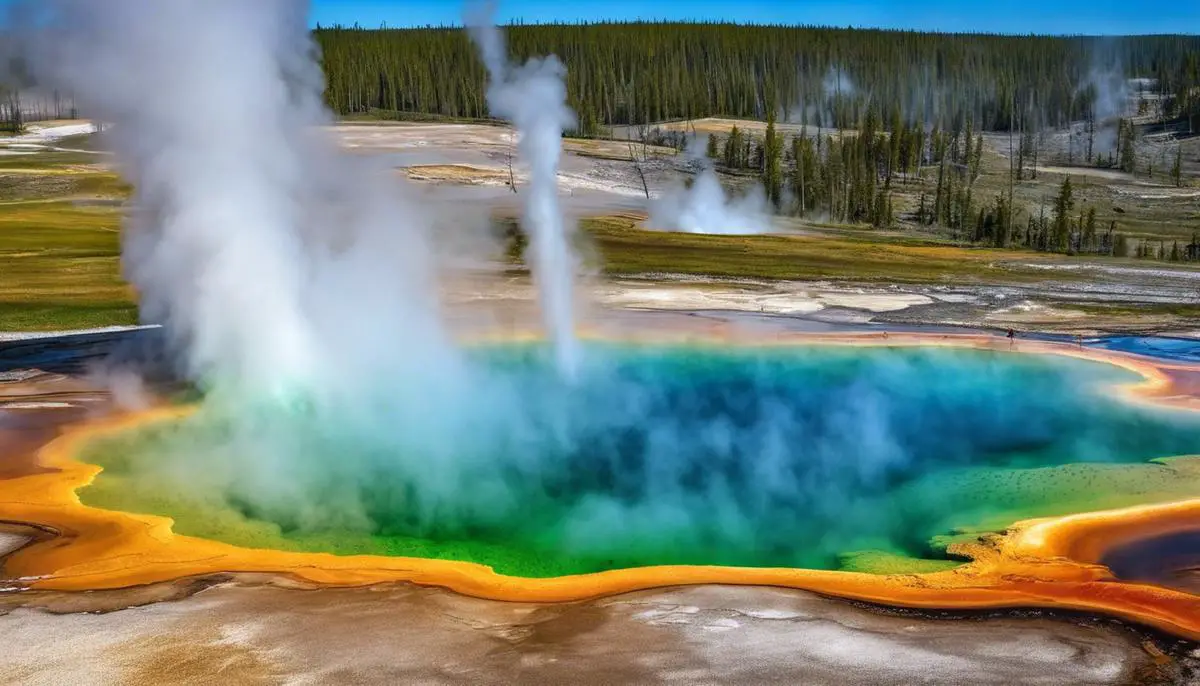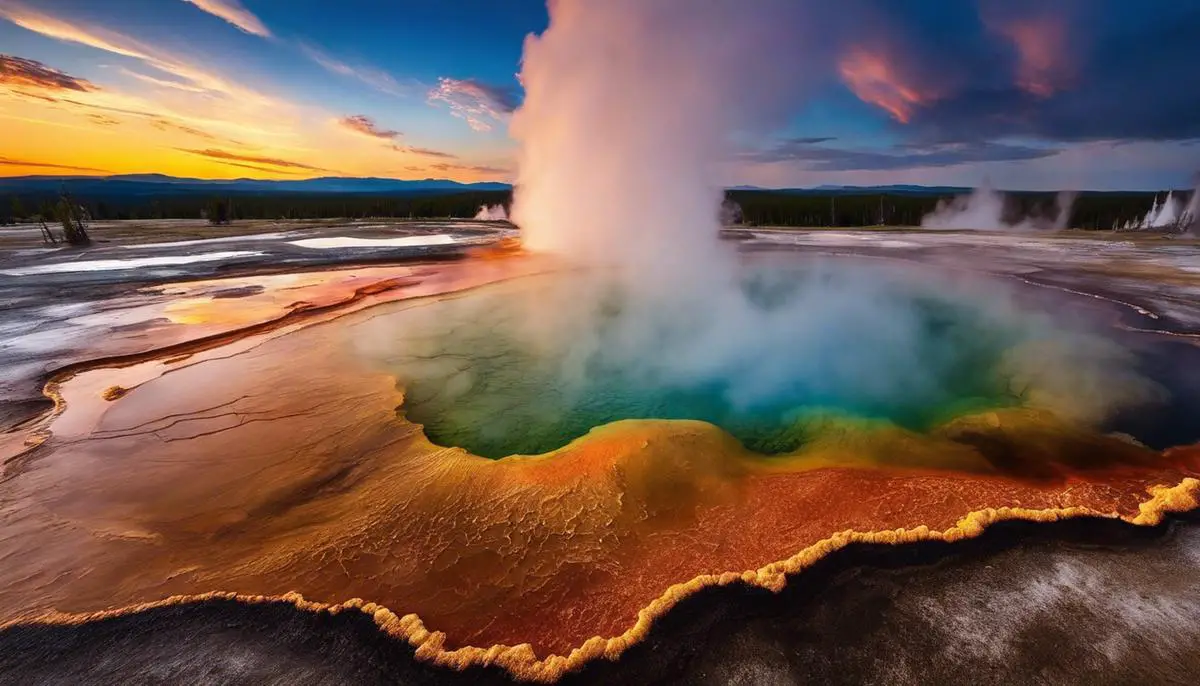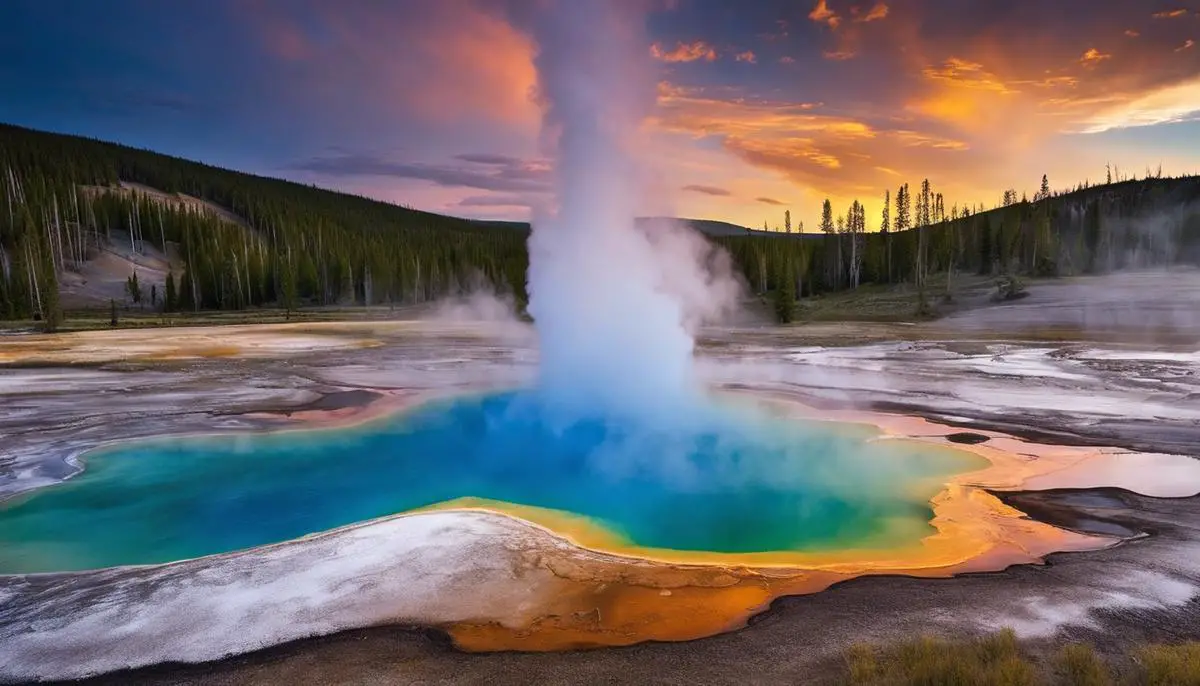Immerse yourself in the intriguing world of geysers – nature’s pressurized water fountains, aptly considered one of the Earth’s remarkable phenomenons. These geological wonders, prominently punctuating Yellowstone National Park’s landscape, draw millions of visitors annually with awe-inspiring displays.
This journey will navigate you through the geological tapestry that allows these beats of volcanic activity to exist, chart a course across the breathtaking spectacle of Yellowstone’s most eminent geysers, and offer practical tips to enhance your visit. Moreover, we’ll trek through scenic trails, skirting these geothermal wonders, and learn about our vital role in preserving them.
Table of Contents
- Understanding Geysers: Natural Marvels
- The Famous Geysers of Yellowstone
- Timing Your Visit: Geyser Eruption Schedules
- Photogenic Spots and Hiking Trails Around the Geysers
- Preserving Yellowstone Geysers: Responsible Tourism
- Related Questions
Understanding Geysers: Natural Marvels
Have you ever experienced the ecstatic thrill of hot water and steam fiercely erupting from the Earth’s surface right in front of your eyes? Welcome to Yellowstone National Park – home to most of the globe’s geysers.
These geysers’ unpredictable yet spectacular explosions light up the park, revealing Mother Nature’s enchanting yet potent character. So, let’s delve into how these remarkable geysers function and celebrate their unique charm.
First, a geyser is essentially a hot spring with a nifty characteristic – it can and does erupt. The stage is set deep beneath the Earth’s crust, where water seeps into the porous rock and descends to meet red-hot magma chambers.
Bingo! That’s where the real action begins. As this water heats up, it expands, turning into steam. Since steam takes up 1,600 times more space than water, the pressure increases dramatically, leading to an explosion that we witness as a geyser erupting!
However, this intricate, geothermal cavalcade of water and high-pressure steam is part of the underground magic. The geyser’s diverse character is the underground plumbing system, typically composed of a long, narrow tube leading to large underground chambers.
This tube, coupled with the chamber beneath, forms a pressure trap. Consequently, when steam attempts to rise (meandering the adage, ‘hot air rises’), it gets stuck behind the cooler water in the narrow passage, creating a colossal geyser-like pressure cooker.
Now, let’s highlight the pièce de résistance – Yellowstone’s own turban-clad marvel, the Old Faithful. This legendary geyser’s eruptions have a beguiling cadence and predictability nearly every 60 to 90 minutes, thereby earning its endearing title.
What sets the gee-whiz geysers of Yellowstone apart is the park’s location on a volcanic hotspot where molten rock (magma) seeps close to the surface. Finding such an extensive collection of geysers in a concentrated vicinity is as rare as uncovering a fully illustrated, first-edition comic book at a garage sale!
This volcanic hotspot gifts Yellowstone its diverse thermal features, including not just 500 geysers but hot springs, mud pots, and steam vents galore.
Exploring these magnificent and well-orchestrated geysers shows awe and reveals the powerful, dynamic forces shaping our planet from below. So, don’t just view the grand geysers of Yellowstone as punctual waterworks. Instead, perceive them as glimpses into the Earth’s fiery heart – a rare spectacle!
Remember, these fascinating geysers carry a potent message: nature is powerful, unpredictable, and profoundly beautiful, even in its most brash displays. So, add Yellowstone to your destination bucket list and savor this one-of-a-kind geothermal banquet!

The Famous Geysers of Yellowstone
Blazing a Trail to the Must-See Geysers in Yellowstone National Park
Rocking the wanderlust vibe and painting your life’s canvas with awe-inspiring experiences leads wanderers like yourself to none other than Yellowstone National Park. Beyond the allure of Old Faithful, many unique geysers reside within the park’s boundaries, each with a distinct eruption pattern and mesmerizing allure.
Embracing the unpredictable and spontaneous essence of the roving lifestyle, Castle Geyser symbolizes every dreamer’s enigmatic charm. Nestled in the Upper Geyser Basin, this mighty thermal feature rests like a fortress made by Mother Nature herself.
Its conical appearance results from centuries of sinter (or mineral) deposits. However, the real show starts when the simmering water and steam blast up to 90 feet in the air. It is a thrilling spectacle that occurs roughly every 10 to 12 hours, making it a dash less predictable than Old Faithful but equally impressive.
Bison graze nonchalantly by rivers of turquoise and gold, oblivious to the bubbling cauldrons of geothermal power beneath the surface. The Grand Geyser is a hypnotic seething spring in the Upper Geyser Basin.
Known as the tallest predictable geyser on the planet, its seismic spectacle is the stuff of legend, reaching up to 200 feet skywards! It’s the must-catch opening act before Old Faithful takes center stage.
Where the trails meander through the geothermal wilderness and the scent of sulfur fills the air, the energetic Riverside Geyser patiently awaits its audience. Sitting on the banks of the Firehole River, this particular geyser adds a splash of drama to the scenic landscape.
Every six hours, erupting for up to half an hour, this geyser breathes life into the river, creating an arched display of steam and water against the tranquil background. Riverside’s leisurely pulse mirrors the lifestyle of a true nomad — unhurried and utterly peaceful.
As close to a thrill ride as nature has to offer, Steamboat Geyser, situated in Norris Geyser Basin, is the world’s tallest active geyser. Its eruptions are somewhat of a surprise party, erupting without warning and flinging water up to 400 feet in the air! Talk about a wild showstopper! So, if you sense some seismic whispers from deep below while exploring Norris, you might be in for a unique thrill that Yellowstone keeps up its sleeve.
Yellowstone embraces your wandering spirit and gifts you with a geological theatre. As you journey through its varied terrain, each unpredictable geyser eruption captures that spontaneous spark, that flame of adventure that burns bright in travelers ready to engage in the marvels and mysteries of the world.
As you pack your gear, remember that these geysers are like all of us digital nomads in their magnificent irregularity and untamed energy. Our hearts pulse with the world’s rhythm, and we wouldn’t have it any other way.

Timing Your Visit: Geyser Eruption Schedules
No Yellowstone adventure can reach its peak until one immerses themselves in the thrilling spectacle of geyser eruptions. Time is correct, and one can witness a soul-stirring performance that Mother Nature has perfected for countless millennia.
To optimize geyser viewing experiences, it’s vital to understand the timetable of these geological marvels. Each geyser in Yellowstone has its eruption forecast, as erratic as the wanderlust of the most spontaneous nomad. This unpredictability adds a sense of thrill and anticipation to the viewing experience.
Perhaps the best-known geyser track in the park is Old Faithful, a quintessential symbol of Yellowstone’s geothermal splendor. Despite the unpredictable nature of geysers, Old Faithful faithfully erupts every 44 to 125 minutes, granting ample opportunities for visitors to admire its awe-inspiring display.
However, stepping away from the limelight are other geysers with equally mesmerizing eruptions waiting to be discovered by intrepid explorers. These include Castle, Grand, Riverside, and the unpredictable but captivating Steamboat geyser.
Speaking of Steamboat, this geyser is the world’s tallest active geyser, shooting water as high as 300-400 feet in the air. Witnessing its occasional significant eruptions is like hitting a jackpot in the lottery of Yellowstone experiences. However, patience is critical for this geyser as significant eruptions occur between 3 days and 50 years apart!
Venturing around the park, the Upper Geyser Basin boasts the highest concentration of geothermal features. This glorious basin provides a golden opportunity to witness several different types of geysers – cone, fountain, and perpetual spouters, each offering unique and breathtaking eruptions.
Being privy to Yellowstone’s impressive geysers, it’s important to remember that the park operates on nature’s time. For those keen to see a specific geyser’s eruption, checking with the park rangers for predicted eruption times is necessary. Remember that these are only predictions, and the geysers follow their rhythm like our wanderlust hearts.
Here in Yellowstone, patience is rewarded with a geological theatre, an experience that cannot be duplicated. So, when planning a trip to the park, allow plenty of time to appreciate these natural wonders fully. Each eruption is unique, never to be exactly replicated, much like the fleeting moments from a journey on the open road.
Like the international digital nomad collecting tales from every corner of the planet, Yellowstone National Park gathers stories from its geysers. Wonderfully unpredictable, gloriously spontaneous, and undeniably awe-inspiring, witnessing the powerful eruptions of Yellowstone’s geysers is an adventure not to be missed.
Let the allure of these steaming spouts summon your nomadic spirit to this impressive show of nature’s raw power. This is Yellowstone, where the wilderness meets the wanderer – let the exploration begin!

Photogenic Spots and Hiking Trails Around the Geysers
Embarking on a journey to discover the picturesque trails around Yellowstone’s geysers offers an immersive experience that defies the usual boundaries. It’s all about diving into the heart of nature, trekking alongside geysers while experiencing vast wilderness spaces, rugged mountains, and unrivaled wildlife.
Intrepid nomads know that every spot in Yellowstone National Park offers a unique charm; nevertheless, some places emanate an irresistible allure.
Commencing with the Norris Geyser Basin, nature lovers are enchanted by the park’s hottest and oldest geothermal area. Here, the Back Basin trail lets visitors leisurely explore a forested landscape with intriguing geysers such as the Steamboat Geyser, the world’s tallest active geyser.
Moreover, the Porcelain Basin trail reveals an alien-like landscape. Trailblazers can witness the largest concentration of geysers in the world by walking this barren, treeless area. Features to look forward to include the Ledge Geyser celebrated for its angled eruptions that gracefully skim against the basin’s wall.
Not too far, Roaring Mountain offers a spellbinding sight of a mountain alive with steam vents, known as fumaroles, hissing an ethereal melody. Although there’s no official trail here, the view from the road is a spectacle.
The Lower Geyser Basin sprawls across almost 12 square miles. Here, nomads can stroll around the Fountain Paint Pot Nature Trail, a half-mile loop that introduces travelers to all four hydrothermal features in the park: mud pots, geysers, hot springs, and fumaroles. Don’t miss the playful eruptions of the Fountain Geyser, which usually lasts about 30 minutes, held against the very colorful backdrop of the Celestine Spring.
Trekking on to the Midway Geyser Basin, a jaw-dropping panorama awaits. It’s home to the Grand Prismatic Spring, the park’s largest hot spring, renowned for its mesmerizing rainbow of colors. Starting from here, the Fairy Falls trail offers a perfect vantage point to appreciate this vibrant spectacle.
Lastly, the West Thumb Geyser Basin, perched on the edge of Yellowstone Lake, introduces a serene setting where water bodies intermingle. The tranquil lake meeting the bubbling hot springs and sporadic geyser eruptions creates incomparable scenery. The easy-to-navigate boardwalk trail here offers an opportunity to witness the Abyss Pool, noted as the park’s deepest known hot spring.
Tread gently; tread responsibly! Every footstep around the geysers is an ode to the majestic power of nature that brews beneath, visible upon the surface as a testament to Earth’s dynamism. Remember to stay on designated trails and boardwalks since the ground within hydrothermal areas can be dangerous and fragile.
Enjoy and respect the natural drama. The spectacle of geysers spurting hot water and steam into the sky is Yellowstone’s rhapsody, played anew daily, waiting to etch impressions of immeasurable wonder on every nomad’s heart.

Preserving Yellowstone Geysers: Responsible Tourism
Venturing out into the grandeur known as Yellowstone National Park, it’s pivotal to acknowledge and respect that we are visitors to Mother Nature’s living room.
As we marvel at the geysers, steam vents, and hot springs she has conjured, a commitment to responsible tourism is obligatory. After all, preserving these wonders for future explorers warrants our highest regard.
One critical method of showcasing admirable tourist behavior is adhering to the park’s rules and regulations. Yellowstone operates under the title “do not touch” – a mantra that, when respected, counters human-incited erosion and safeguards the park’s geological gems. It’s about “take only pictures, leave only footprints.”
Stepping lightly is not just symbolic. When navigating the earthen paths that snake around Yellowstone’s emblematic hydrothermal basins – such as the world-renowned Norris Geyser Basin and the colorful Lower Geyser Basin – it’s paramount that one sticks to the designated boardwalks and trails.
Disregarding this rule jeopardizes personal safety due to the scalding hot water beneath the thin crust and can damage the delicate geothermal features.
The responsibility extends to a particular consideration for Yellowstone’s wildlife. As fascinating as it can be to glimpse a bull elk locking antlers with a rival or a grizzly bear foraging for pine nuts, maintaining a safe distance – at least 100 yards from bears and wolves and 25 yards from other animals – is non-negotiable. The exact distance rule applies to geysers and hot springs, a protective approach to prevent geothermic misadventures.
Equally, any feeding, touching, or otherwise interfering with the wildlife is a categorical interference with the park’s ecology. Remember, Yellowstone is not a zoo, and respecting the freedom and health of the animals that call it home is essential.
Consciousness of noise is another crucial aspect to consider. Limiting loud voices, music, and other intrusive sounds maintains the serenity within the wilderness and causes less disruption to the wildlife.
Carrying in and back out all trash and recycling, instead of disposing of these items in the park or leaving behind anything – including food, is another fundamental rule to follow. With millions of people visiting Yellowstone each year, even the most minor items can accrue into big problems, impacting natural processes and the livelihood of animals.
Remember, being a mindful steward while exploring Yellowstone, or any national park for that matter, is not just recommended; it is expected. It’s how we ensure that our love for travel isn’t at odds with our love for the planet.
It’s a promise that we’ll leave Yellowstone just as we found it, or even better, ensuring these wonders are preserved for future generations of nomads. Happy exploring!

As we reflect on the splendor of Yellowstone’s geysers, it’s impossible to shake off the profound connection these phenomenal features create between us and our planet’s volatile underbelly. Each scalding water and billowing vapor spurt reminds us of the incredible geothermal forces operating beneath our feet.
The quirks of Old Faithful, Steamboat, and others we encountered en route accentuate the park’s rich geothermal diversity. Beyond simply marveling at nature’s spectacle, the onus is on us to tread gently, nurture this extraordinary ecosystem, and safeguard its wonders for future generations.
As you take back memories captured in heart and lens, remember to pack away a sense of responsibility, too, a little souvenir from the Earth’s underground realm – the world of Yellowstone’s geysers.
At A Bus On A Dusty Road, we talk about travel, life, and ex-pat living. We are all about “Living Life As A Global Citizen.” We explore social, cultural, and economic issues and travel.
We would love to have you be part of our community. Sign up for our newsletter to keep up-to-date by clicking here. If you have any questions, you can contact me, Anita, by clicking here.
Listen to our Podcast called Dusty Roads. You can find it on all major podcast platforms. Try out listening to one of our podcasts by clicking here.
Subscribe to our A Bus On A Dusty Road YouTube Channel with great videos and information by clicking here.
Related Questions
Which Airport Is Close To Yellowstone? And Other Yellowstone Airport Travel Facts
West Yellowstone Airport is the closest airport to Yellowstone National Park. The airport is only a few miles from the park entrance but has a limited flight schedule and is not open all year round. Other airports include Jackson Hole Airport and Bozeman Yellowstone International Airport; both offer more flights, car rental, and ground transportation options.
By clicking here, you can discover Which Airport Is Close To Yellowstone? And Other Yellowstone Airport Travel Facts.
Best Way To Visit Yellowstone Without A Car
If you want to visit Yellowstone National Park and do not want to rent a car, it is possible to see the Yellowstone National Park without a car. One of the best ways to do this is to fly into an airport close to Yellowstone Park.
By clicking here, you can discover the Best Way To Visit Yellowstone Without A Car.
Campground Yellowstone National Park – Guide To Reserving
Yellowstone offers a variety of exceptional camping options, but to make the most of your experience, you’ll need to know what type of campsite you’re interested in and the specific requirements for reserving it. This knowledge will help you navigate the reservation process more smoothly and secure your ideal camping spot.
By clicking here, you can discover Campground Yellowstone National Park – Guide To Reserving.


